Trending
Opinion: How will Project 2025 impact game developers?
The Heritage Foundation's manifesto for the possible next administration could do great harm to many, including large portions of the game development community.

Featured Blog | This community-written post highlights the best of what the game industry has to offer. Read more like it on the Game Developer Blogs or learn how to Submit Your Own Blog Post
The evolution of JRPGs in the 6th console generation. The rise of 3D environments, abstract game systems, and ever-younger protagonists.

The full article with screenshots and miscellaneous tid-bits was originally posted on the game design blog Significant-Bits.
Following an era where the PSX reigned supreme, the sixth console generation got a significant hardware upgrade with more storage space, larger resolutions, higher poly counts, etc. The extra horsepower allowed for many genres to better realize their settings and mechanics, and JRPGs were no exception.
Real-time combat was no longer limited to the Tales and Star Ocean series, and freeform movement opened the door for various new action-RPGs like the massively successful Kingdom Hearts.
Turn-based party-battlers were still plentiful, but it was perhaps the first step to catering for a broader audience at the cost of alienating older fans.
It was also when JRPGs lost me.
The higher fidelity presentation meant that previous abstractions were now shown in their full glory, or lack thereof. Instead of a pixelated knight bowing his head and saying a single dubiously-translated line of dialogue, the protagonist was now an emotional teenager -- complete with grating voice acting and a smirking portrait -- blathering on for entire paragraphs with rarely an option to skip ahead.
There were no longer any blanks to fill, and the added content was skewed for a younger demographic. Consequently I didn't play any of these games upon release, and about half of them were brand new to me.

The Dreamcast was something of a stopgap before the PS2, Xbox, and GameCube truly ushered in the new console generation. The first of its standout JRPGs was Grandia II, the most fondly remembered entry in the series that received multiple re-releases over the years.
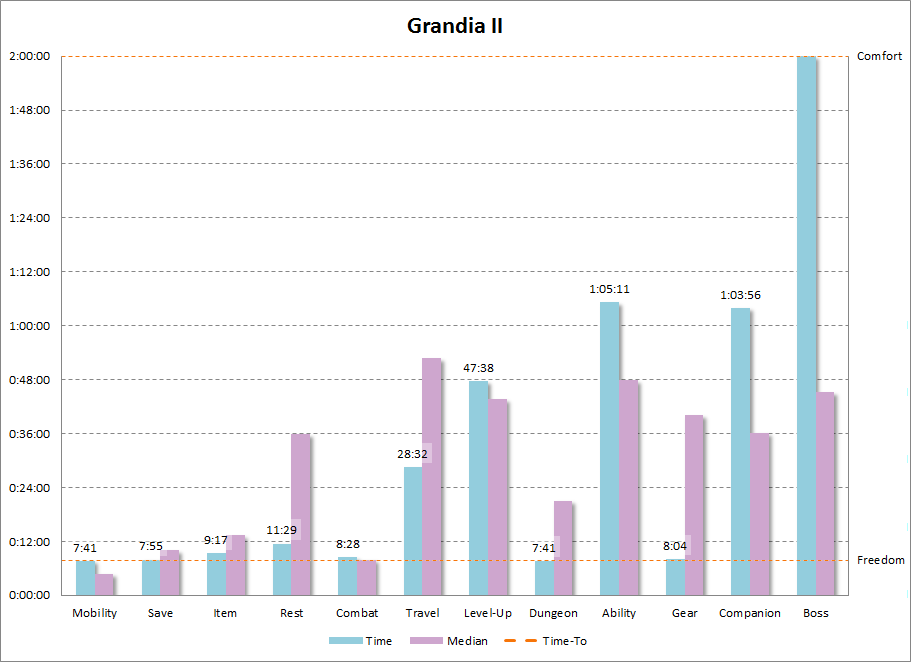
The opening of Grandia II smacks of the previous generation. It starts with a short anime video, followed by an in-engine cutscene involving various characters, and is capped off with another in-game cutscene introducing the protagonist.
Despite showing some combat encounters, this opening is entirely non-interactive and unskippable. However, as soon as it's finished the milestones come rapidly.
The opening area is a mini-dungeon, with a save point close-by. Combat is initiated via on-screen enemies that glow red when they spot the player.
After the initial encounter, the first gear upgrade is obtained, followed by the first consumable, and finally a rest spot. All of this takes less than 5 minutes, and the overworld map is reached within half an hour.
From there, things slow down a bit as the first town is reached. NPCs often have different things to say when they're spoken to repeatedly, and the plot necessitates some dungeon exploration. A level up takes place during this quest, and the first companion joins upon returning.
Ability customization follows right after, but 2 hours proves not quite enough time to reach the first boss.
FTC: NA

Just a couple of months after Grandia II, the Dreamcast got its other landmark JRPG: Skies of Arcadia. While it was critically acclaimed for its lighthearted, adventurous spirit, it didn't sell as well as expected. The game only got a GameCube upgrade, with various other re-releases being cancelled.
Despite this, Skies of Arcadia is fondly remembered as a title that hearkens back to what made JRPGs great in the previous generations.

After a short, in-engine cinematic, the player is thrust directly into combat. When the battle ends, the party finds itself in a dungeon with an item close by. With a bit of exploration and fighting, the first level up is achieved just before finding a save point. Within 10 minutes of the initial combat, the dungeon's boss is encountered, and a new ability is obtained after his defeat.
When the party escapes to the overworld, the rapid pace slows down a little. This is the first time any tutorials are presented, and the player gets to explore the land aboard their airship.
Back in the protagonist's home town, some shops open up and plenty of cutscenes and general exploration takes place. Due to the scripted nature of this segment, there actually is no manual resting until the second dungeon is completed.
Combat is initiated with random battles, which aren't as frequent as many online complaints indicate, but they're not rare either. Consequently the 2 hour mark elapses just before the first new party member joins the crew.
FTC: NA
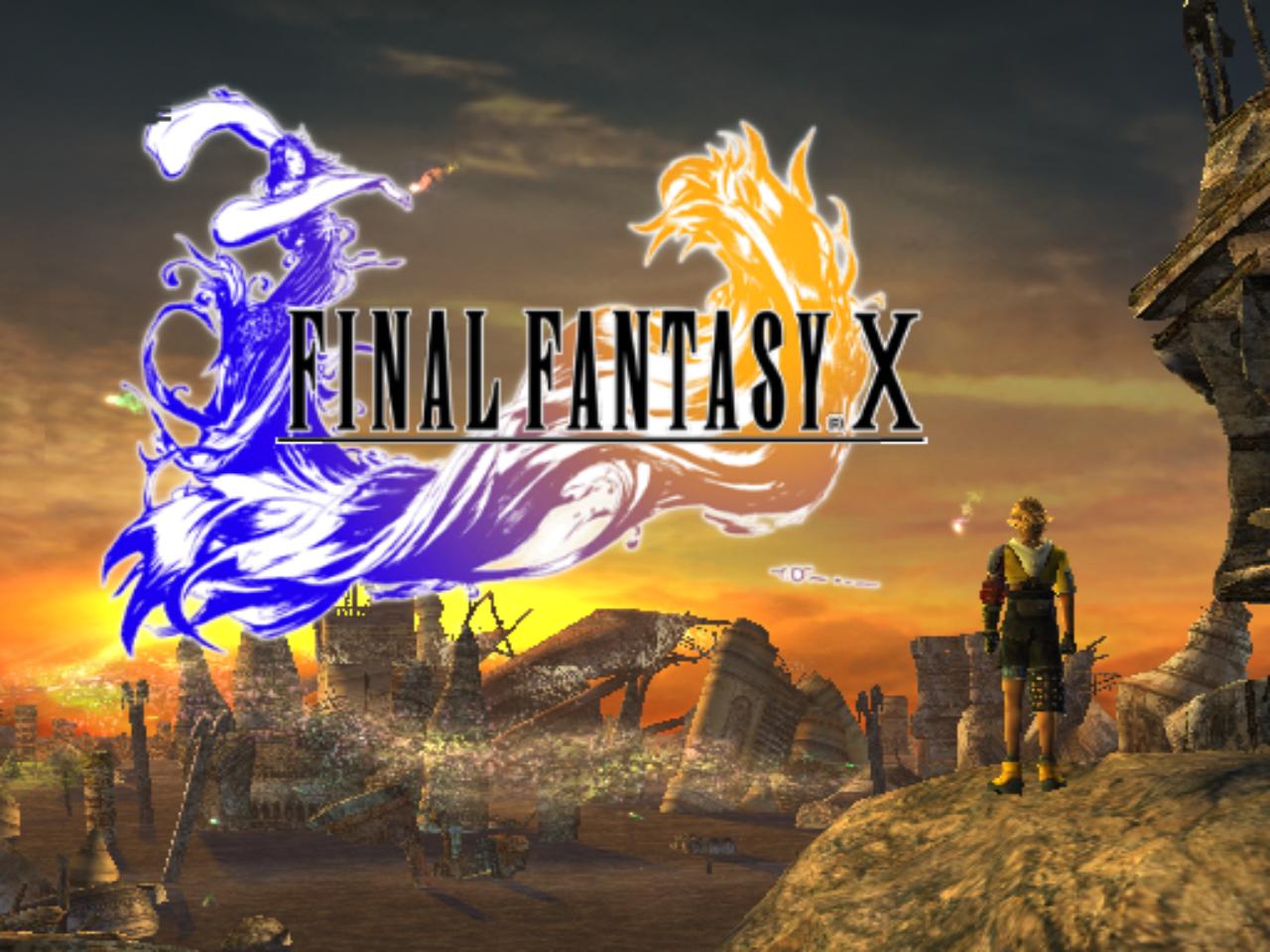
FFVII was a breakout hit on the original PlayStation, and FFX aimed to duplicate that success on the PS2. While it wasn't the first fully 3D JRPG, FFX's production values were significantly higher than those of its contemporaries. Voice overs and custom animations were no longer limited to prerendered cinematics, and the overall fidelity was a clear step up.
It might not have been as drastic a transition as the series' previous generational leap, but the sales and critical reception of FFX all seemed to indicate that it lived up to its hype. Consequently it received various remasters, and was the first mainline entry to get a direct sequel.
It was also the first Final Fantasy game that I gave up on when it deposited a net in my hands and told me to go catch some butterflies.
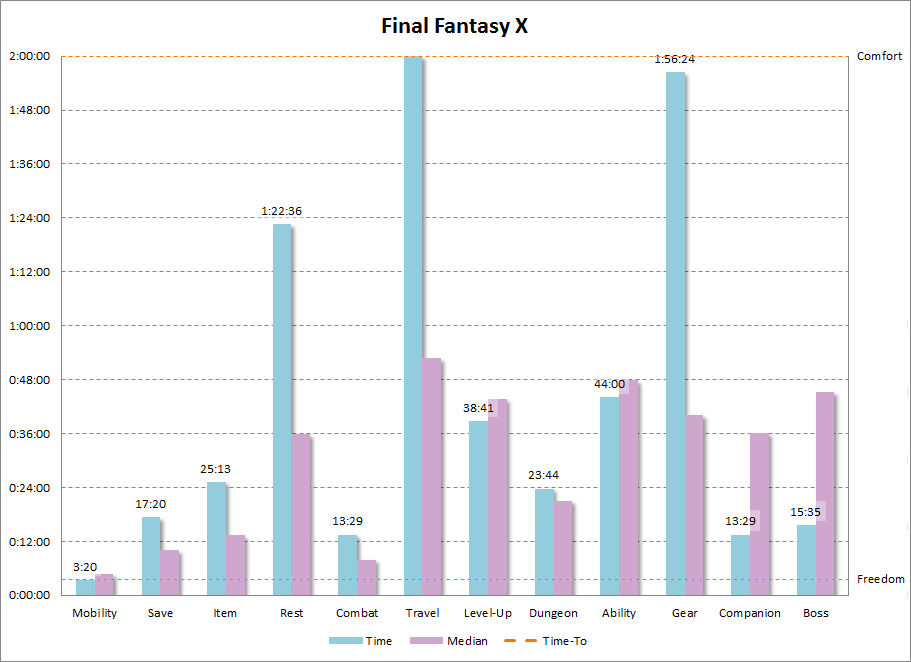
After a short and somber intro showcasing the game's cast, the player takes control of Tidus, a professional athlete on his way to a sports match.
Following 10 minutes of fan-conversations and some very linear exploration, the event kicks off but is immediately interrupted by a huge monster attacking the city. A companion quickly joins up, and the first battle takes place. The combat is quite fast, with hasty animations and the old ATB system being replaced with one that instantly skips to the next combatant's turn.
The intro combat sequence is quite interesting as the party faces enemies both in the front and back, with the rear enemies respawning if killed. By defeating the front ones, the party "moves forward" without exiting the battle scene. Eventually an easy boss fight takes place, and a save point is found right after.
Following some surreal cutscenes, the player is deposited in the first dungeon. The area is quite atmospheric, with the mystery of what just happened and where the protagonist finds himself squarely in the forefront. There are no immediate explanations, just monsters and a sense solitude. An item is found pretty quickly, and after some light puzzles and a level up, a human faction is encountered that speaks a foreign language (a rarity in JRPGs).
The encounter with the Al Bhed results in a lengthy tutorial on obtaining abilities, and yet another dungeon. The protagonist is eventually separated from the group and transported to a whole new location. Here the game proper begins, and after a lot of cutscenes, tutorials, and exploration, the first reusable rest spot and equipment are discovered.
However, it's not quite enough to reach the next hub within 2 hours.
FTC: NA
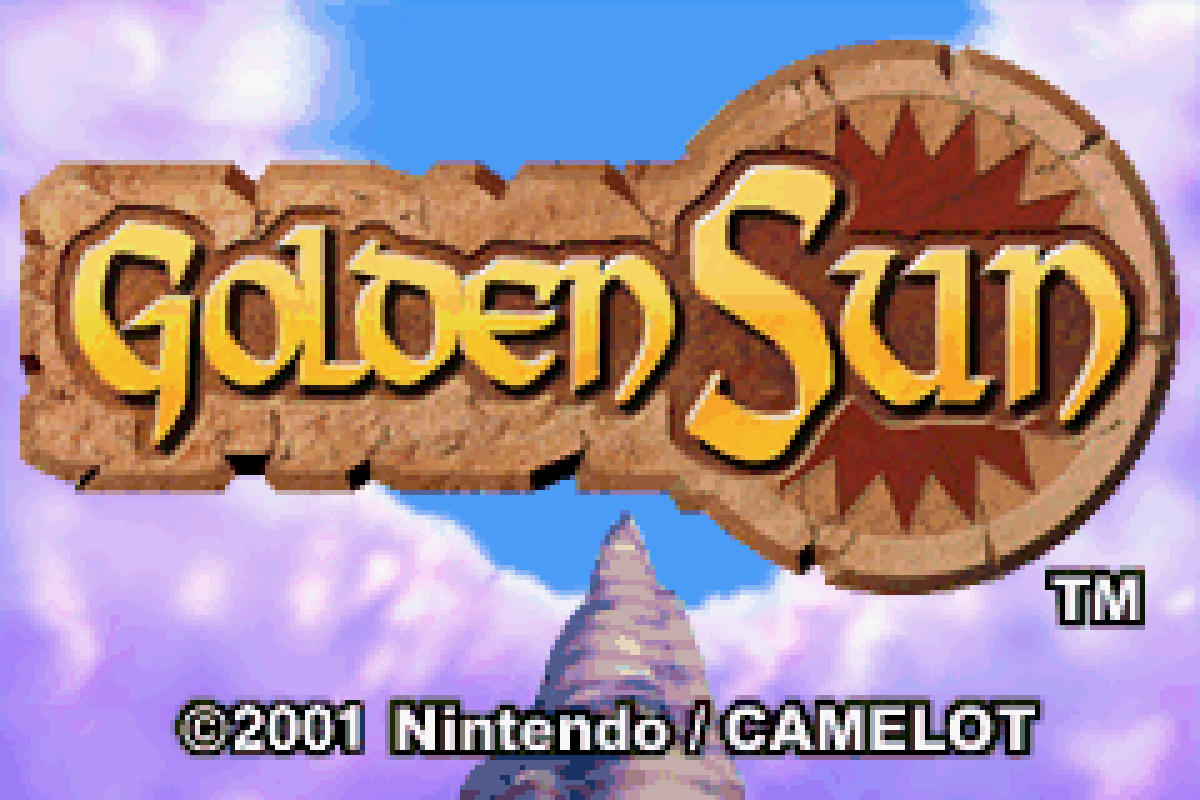
Golden Sun served as something of a next-step JRPG for Pokemon fans. It was split into two titles on the Game Boy Advance, and received a sequel on Nintendo DS. Despite not selling a tremendous amount, the series gained a cult following that cherished its focus on puzzle dungeons.
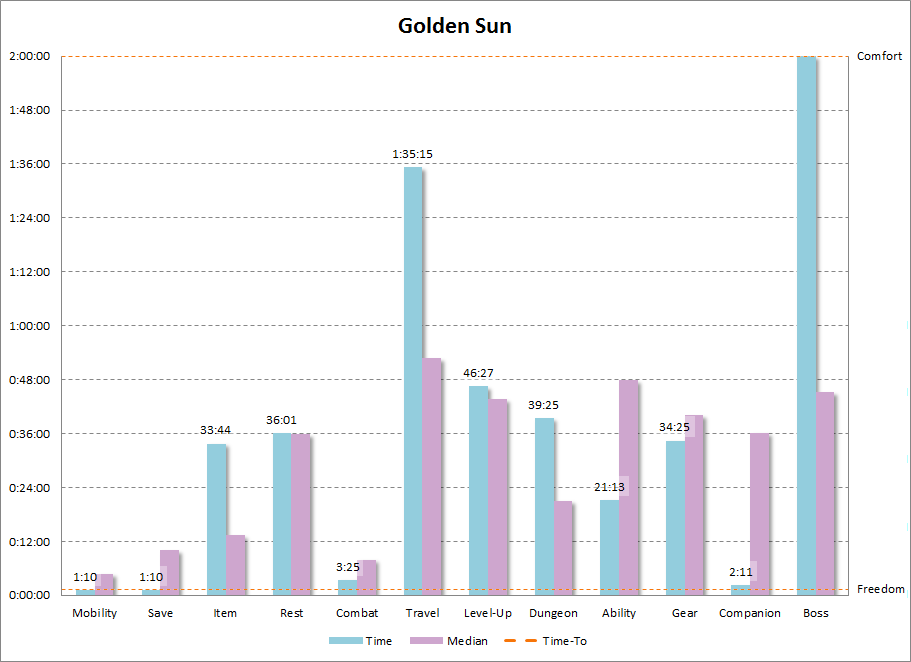
Golden Sun starts off very quickly by making the introduction largely interactive. Saving can be done at any point from the main menu, and a companion joins up right before the first fight. However, the rest of opening slows down to an crawl due to the first instance (at least on these lists) of text-grind.
Just like in visual novels, all characters have a lot to say. They constantly repeat themselves, restate and confirm the obvious, and generally take a long time to say nothing.
The cramped text box doesn't help matters, but what's even worse are the constant dialogue interruptions. Characters not only take breaks to change poses, but also display floating emojis to reaffirm their emotional state. These elements really drag out the first half-hour, and the only new milestone during this time is obtaining a puzzle-related ability.
Eventually some shops open up providing items & equipment for purchase, and the first rest spot becomes available. The dungeon that follows isn't too difficult, but random encounters are quite frequent and the combat has a halting flow. This is mainly due to a Dragon Quest like battle log where each message must be manually confirmed.
Just over an hour and a half into the game, the opening sequence finally ends. The party sets out on the overworld map, but this doesn't leave enough time to encounter the first boss.
FTC: NA
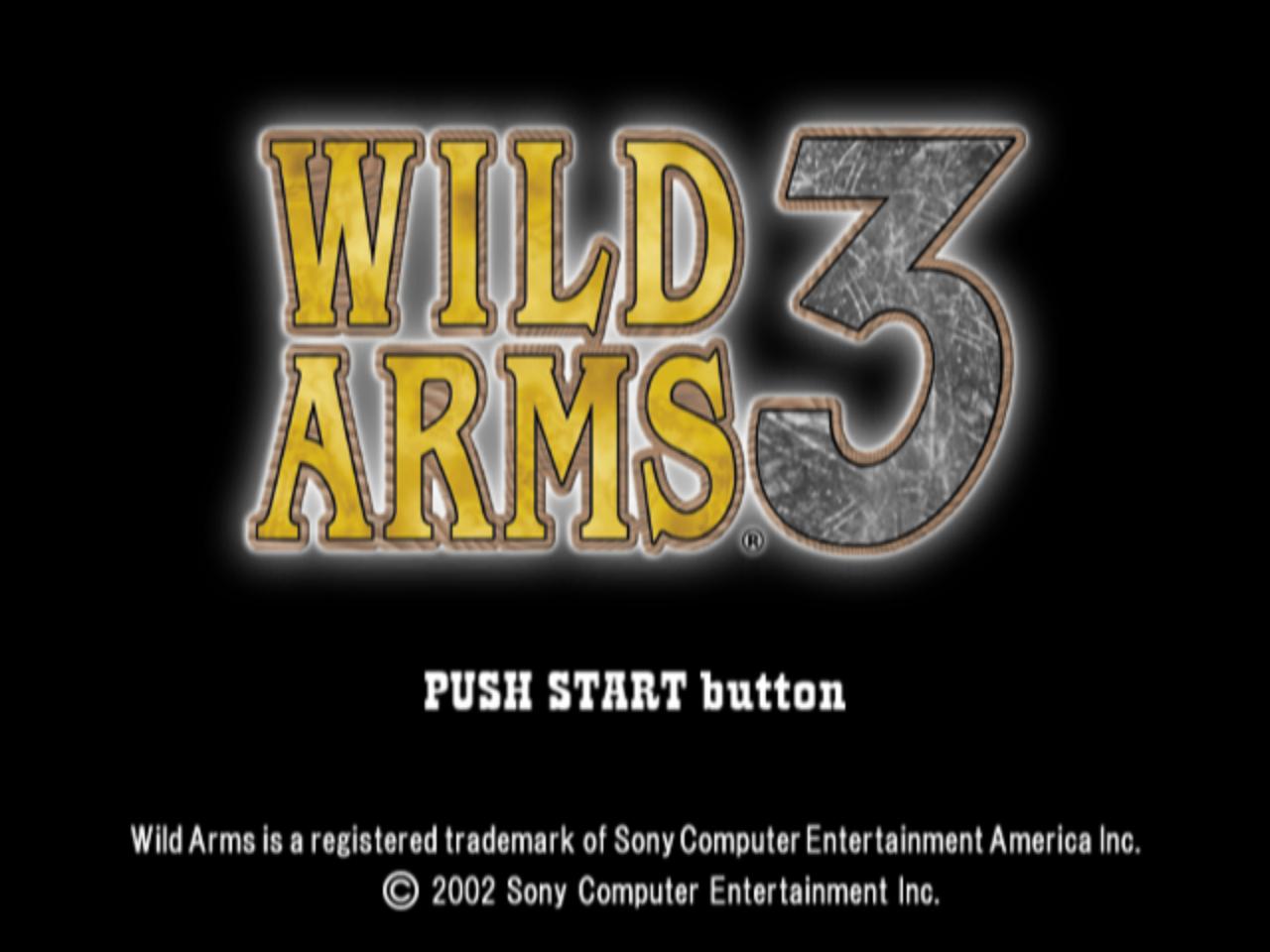
Despite its reputation for being a Western-themed series, Wild Arms always focused on magic, monsters, castles, mechs, and other common trappings of JRPGs. Out of all the games, Wild Arms 3 came closest to capturing the vibe of the Wild West, and is arguably the series' standout entry.
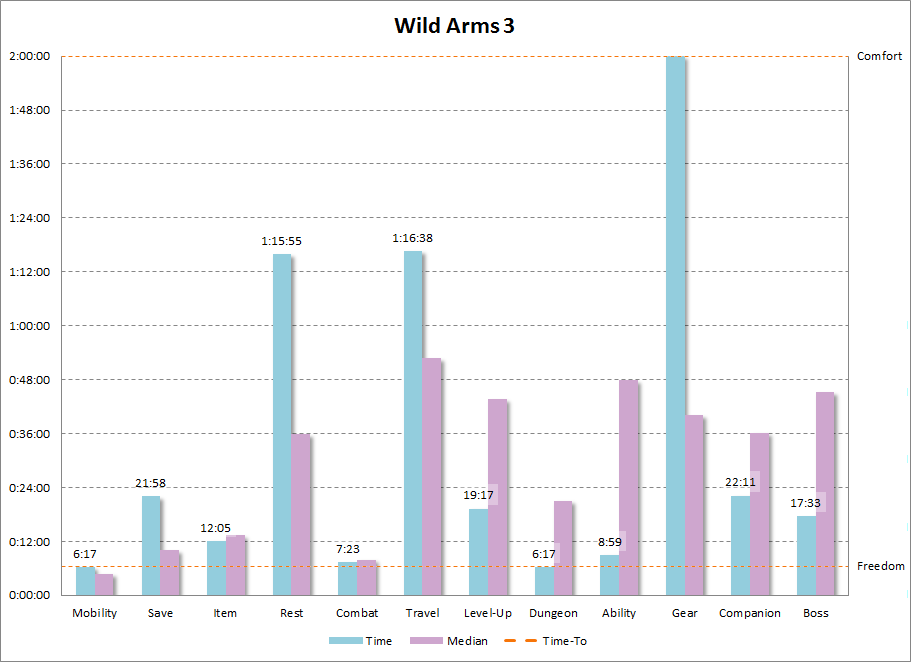
A scripted sequence introduces something of a crisis aboard a train, with the four main characters facing each other in a standoff. This serves as a character select screen, with the option to play through the prologues in any order before the game proper begins.
Starting with the default character, a short cutscene plays before she's ushered into the first dungeon. Combat takes place right away, and an ability is found shortly after to help with environmental puzzles. The first items is collected following some exploration, and within 10 minutes the first boss encounter takes place.
When the boss is defeated, a level up takes place and a save option is presented before moving on to the next character's section. This pattern continues for all party members, which is why there's a long delay before resting and overworld travel come in at around the 75 minute mark. The last dungeon also proves too lengthy to obtain the first gear upgrade before the 2 hour marks elapses.
FTC: NA

Prior to their success with Xenoblade Chronicles, Monolith Soft aimed to shore up the GameCube's scarcity of JRPGs with Baten Kaitos. Teaming up with tri-Crescendo, the two companies strayed a bit from tradition by basing the game's combat on a card system.
The reception of Baten Kaitos was generally positive -- it's easily remembered as one of the console's best JRPGs -- but this did not result in tremendous sales numbers. A sequel was met with a similar reception, and the series was shelved soon after.
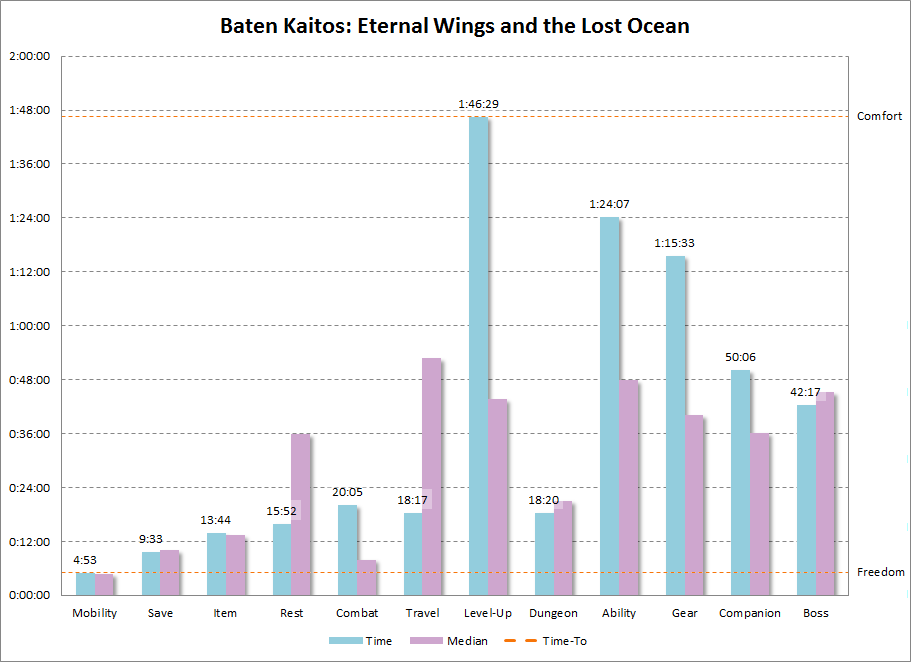
Following a 5 minute intro, control is given to the player in a small village with a save point, an item store, and a rest spot.
While beautiful looking, the scripting system shows its age with rigid, state-driven cutscenes. These require a fade-to-black intro and outro, resetting the position of all applicable NPCs and party members. Not only does this add an unnecessary delay, it also comes across as very awkward when the reset leaves all characters in the same spots.
Exiting the village leads to a miniaturized overworld map reminiscent of Chrono Cross. Here all key locations are close by and no random encounters take place. Entering the first dungeon is soon followed by combat, but the exploration is a much lengthier process. The areas aren't sprawling, but a constant stream of new cards necessitates a fair amount of deck management.
After roughly 25 minutes in the dungeon, a boss battle takes place and a companion joins up after its defeat. From here things slow down considerably with more cutscenes and another dungeon area.
At the 75 minute mark, the first equipment upgrade is obtained, followed 10 minutes later by a brand new ability. The final milestone is hit in the second, much larger town where the mechanism for leveling up is finally unlocked.
FTC: 1:41:36
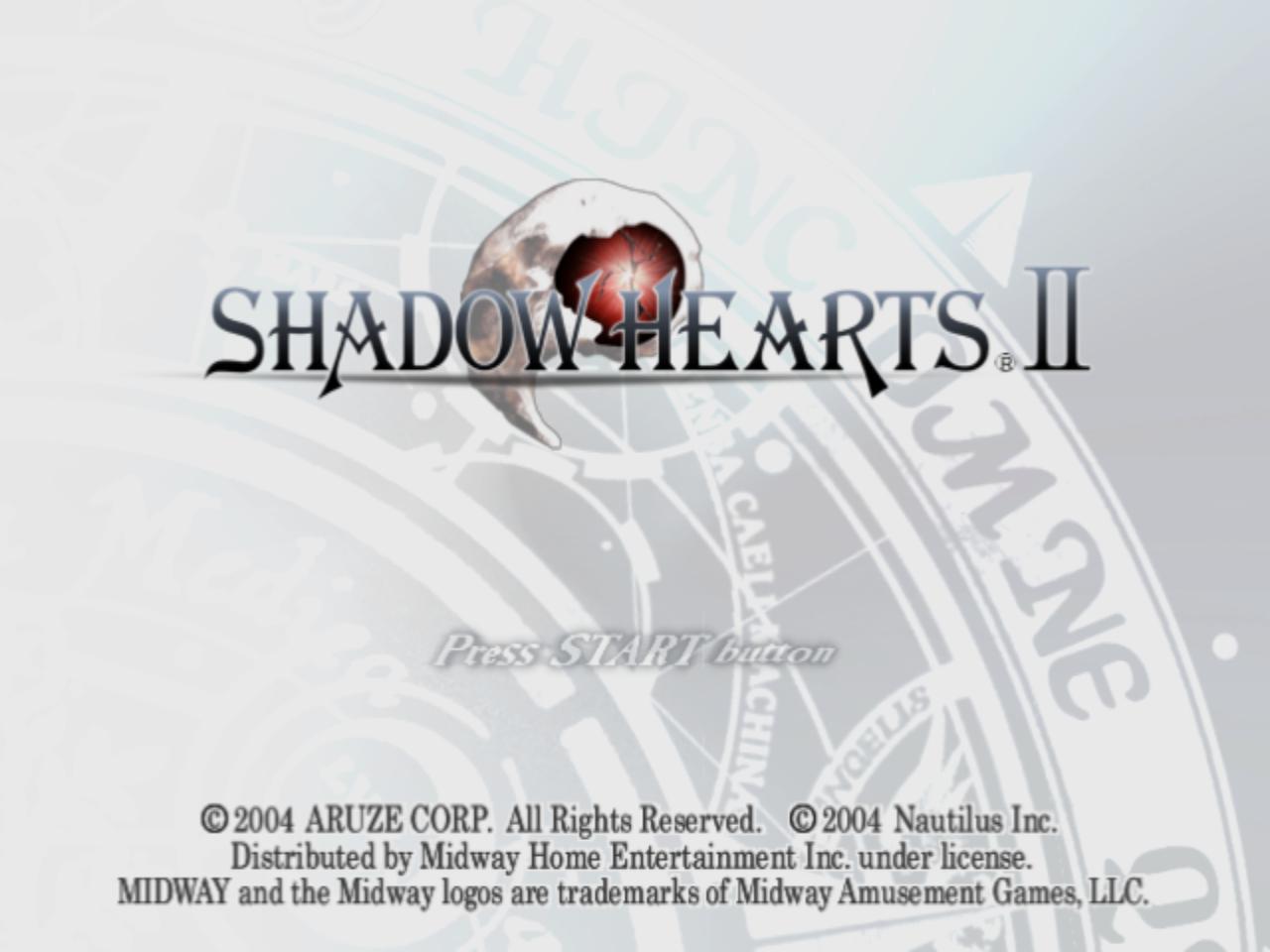
As a successor to Koudelka, Shadow Hearts took place in a fantastical version of our Earth just prior to World War 1. It combined wacky anime stylings with various occult elements of both the West and the East. Its own sequel, Shadow Hearts: Covenant, continued the tradition and picked up the story right after the first game ended.
Despite moderate sales, the PS2 series is a true cult-classic that's lauded for its unique setting and combat mechanics.
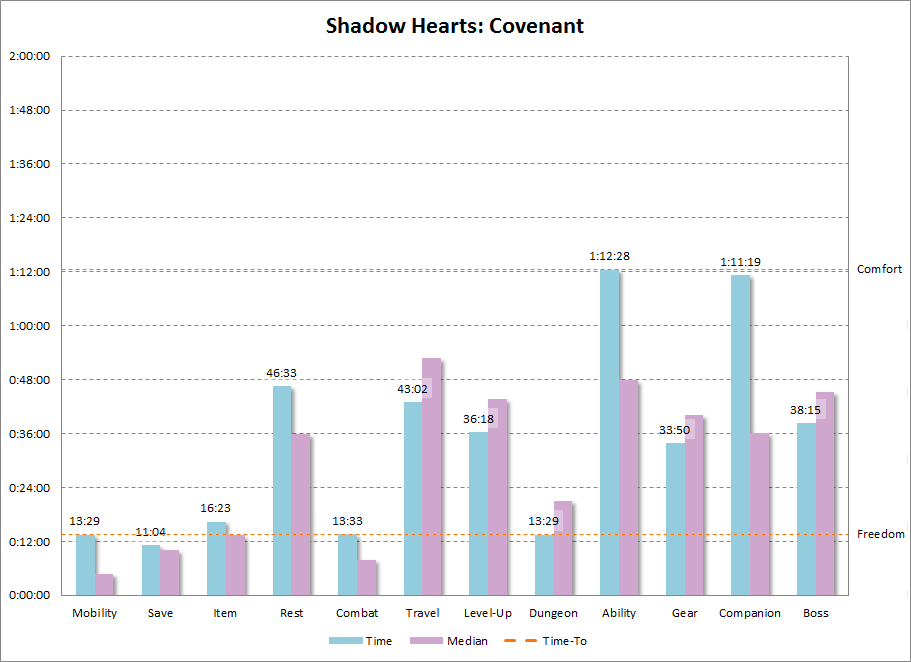
The intro is fairly lengthy, actually allowing the player to save a few minutes before its conclusion. When the opening finally ends, the player is deposited in the first dungeon just before 15 minutes have elapsed.
Exploration is almost immediately followed by combat, and a few minutes later the first item is picked up. Tutorials accompany most random encounters during the next 20 minutes, which is somewhat understandable given the complexities of the battle system. The timed inputs of the Judgement Ring are used for many different action, and a combo system provides further options that are available from the get-go.
Hitting milestones picks up again during a 10 minute span where new gear is obtained, the first level-up takes place, the first boss is encountered, and the node-based overworld map is unlocked.
The second dungeon is of similar length to the first, but provides a rest spot early on. Roughly half an hour later, the party composition goes through a shake-up, and the final milestone is hit when a new ability is obtained.
FTC: 1:01:24

After the original Super Mario RPG, Nintendo and SquareSoft parted ways on rather unfriendly terms. This left the Nintendo 64 bereft of marquee JRPGs, leading Mario's creators to develop their own quirky, papercraft-inspired sequel.
Nintendo continued this series with a GameCube sequel that improved on virtually all elements of the original. The Thousand-Year Door oozes charm, and stands the test of time better than perhaps any of its contemporaries.
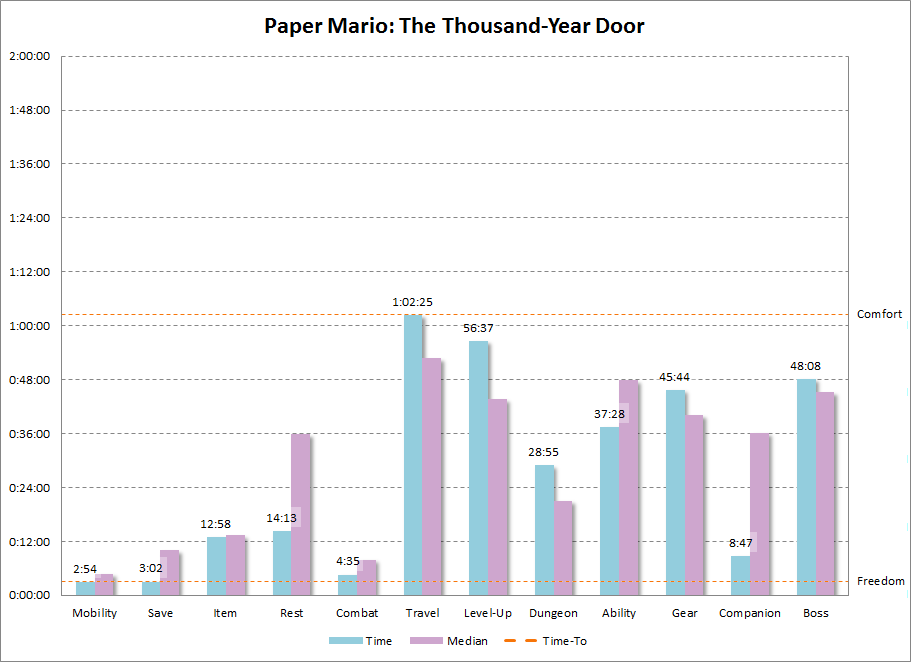
After a quick, storybook-framed intro, the player is deposited in a seedy port town. A save point is visible in the distance, and just beyond it Mario gets himself into a rather comical scrap.
The character he rescues eventually joins up, and exploring the town quickly reveals an item shop and an inn. A series of thorough tutorials and cutscenes follow, but within the first half hour Mario finds himself in a dungeon.
The underground area is fairly small, but has a decent amount of side areas and interactive elements. Enemies are visible on the map and can be avoided, but due to input-mechanics, actual combat takes a fair amount of time. Thankfully defeated enemies don't respawn while in the dungeon, making backtracking quick and easy.
A new ability must be obtained in order to proceed, which leads to the first equipment upgrade and boss fight. This doesn't immediately result in a level-up, but that takes place right after reaching the next area. Once there, a linear path guides Mario to the second hub-town, hitting the final milestone just over an hour into the game.
FTC: 59:31
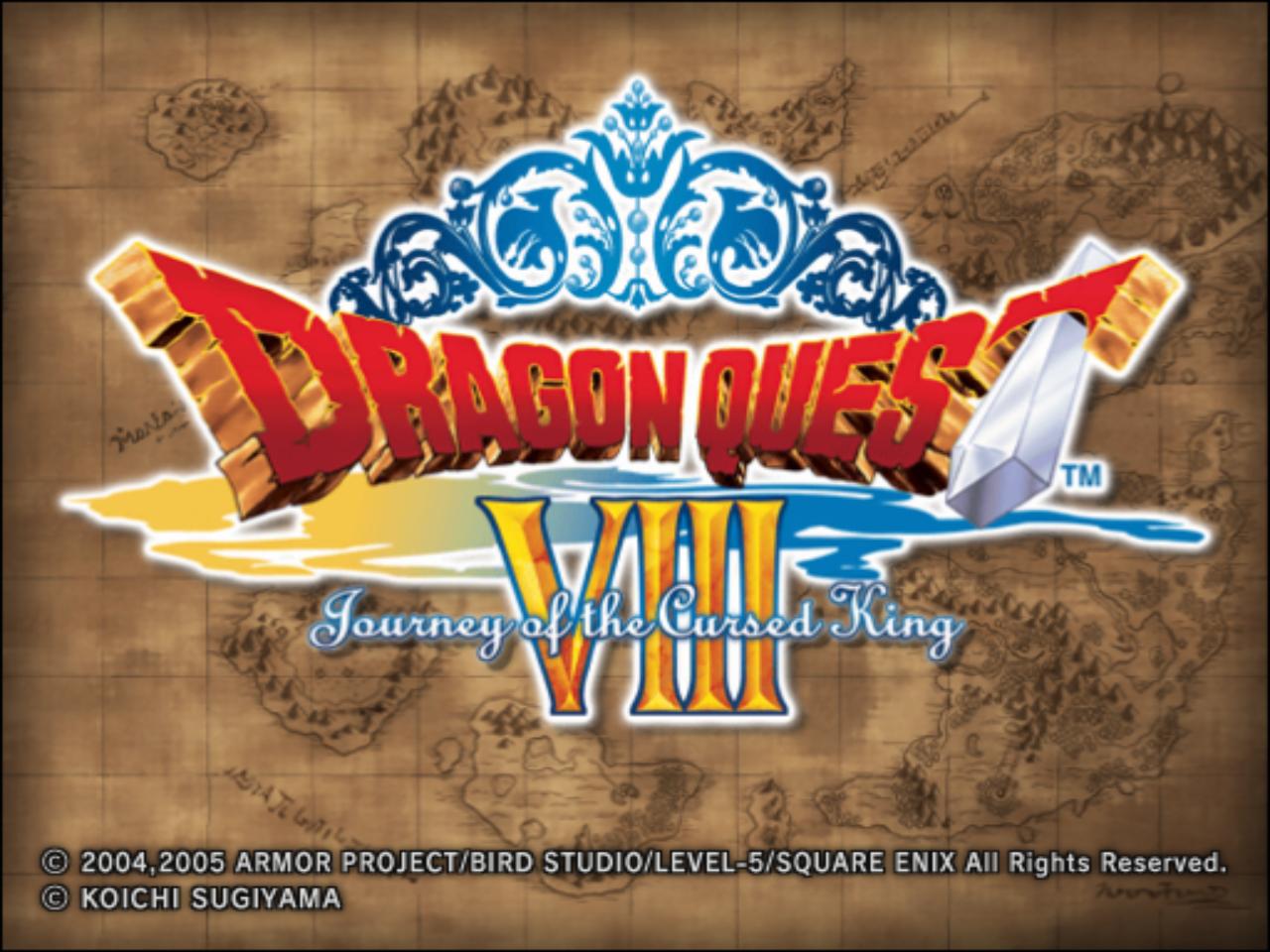
Dragon Quest has historically been something of a comfort-JRPG, holding on to its conventions while being dragged kicking and screaming into each new console generation. Dragon Quest VIII felt like a lot of these holdovers were finally left behind -- Dragon Warrior was no longer its title, voice acting was added, a fully 3D presentation was embraced, etc.
However, thematically the game was still firmly set in its roots. Instead of an epic quest, its narrative felt more like a fairy tale where the party adventured from town to town getting to know the inhabitants and helping them solve comparatively minor problems. This approach finally proved successful both in the East and the West, and Dragon Quest VIII went on to be lauded as a highlight of the series.

After a short 2 minute intro, the player is deposited in a small area and almost immediately enters combat. An item is discovered after the battle's conclusion, and a cutscene has the protagonist's companion officially join the party.
The group eventually arrives at the first town packed with colourful residents. A store provides a gear upgrade, and a fair amount of dialogue sequences take place to progress the story. After the final cutscene, an inn opens up and the city's gates are unlocked.
A path to the first dungeon is evident from the get-go, but the overworld map is presented at the same scale as the town. This results in a lot of time spent exploring even if the random encounter rate isn't overly high. This approach requires multiple trips back to town to restock and recover -- gaining a level and the first ability along the way -- and takes nearly an hour to complete.
The dungeon itself is finally ready for exploration at the 90 minute marks, and the final milestone comes only 15 minutes later with the first boss battle.
FTC: 1:45:47
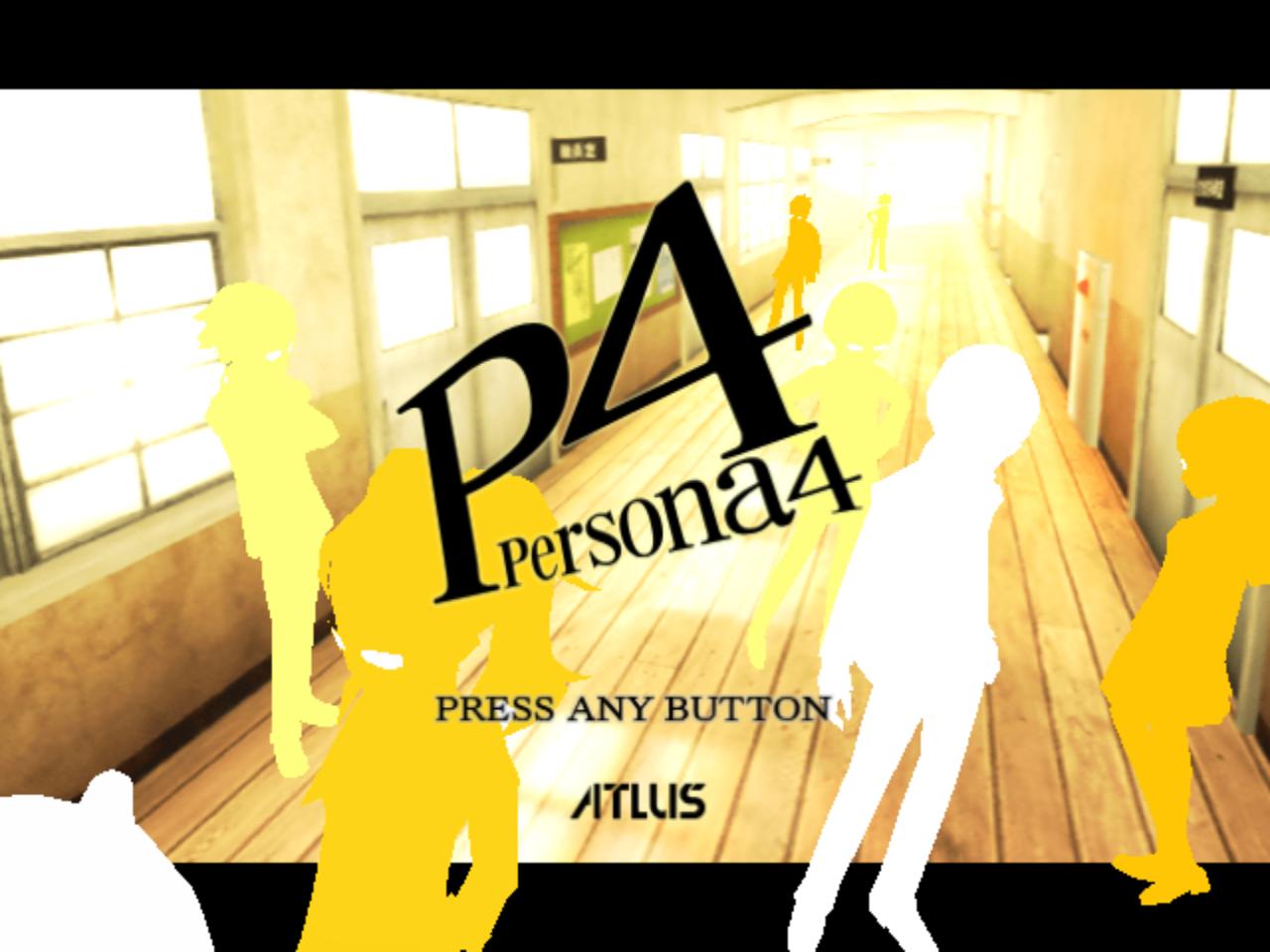
The Persona series started off as one of many MegaTen spinoffs, but developed its own identity over time. Persona 3 was the first entry in the series to really take off, combining the high school setting with new mainstays such as social links, a strict day-by-day timeline, non-combat attributes, snazzy UI, and a pop-y, earworm soundtrack.
Persona 4 ran with these changes and polished them up, segmenting the randomly generated dungeons into narrative and aesthetic wholes, giving full control of all party members, and switching up the setting to a rural Japanese town. It's arguably a series favourite and received multiple spinoffs and upgrades, including a recent PC release.
It's also the only game on this list that I've previously played to completion.
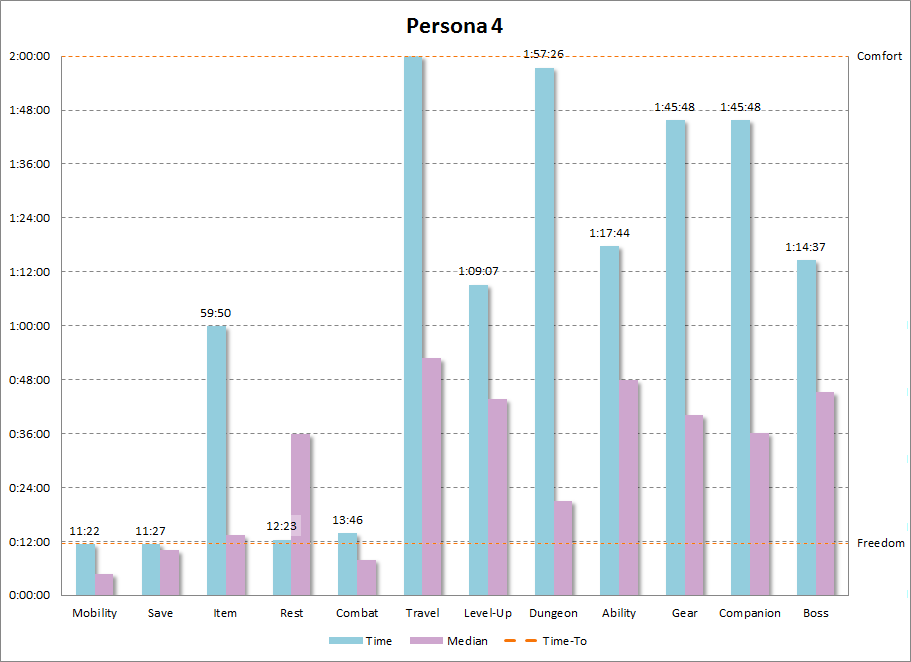
Persona is notorious for aping text-heavy visual novels, but this doesn't take it completely outside the bounds of the 12 milestones. The multi-faceted opening that mixes anime and in-engine cutscenes ends just after 10 minutes, and the game then rapidly hits the mobility, save, rest, and combat milestones.
However, the railroading soon resumes, slowly introducing the setting and the game's narrative hook. This ends at the 1 hour mark, with the party preparing to face the dangers ahead. Within 15 minutes, the first consumable is found, a level-up takes place, a boss is fought, and the first new ability is unlocked. This segment is still entirely scripted, though, with no free movement and all progression stitched together with cutscenes.
The real dungeon preparation takes place at the 100 minute mark, with gear upgrades and the first companion officially joining the party. 10 minutes later dungeon-exploration finally opens up, but this proves not quite enough time to unlock the final travel milestone via a town map.
FTC: NA
There was a general rise in 6th generation median times, but it wasn't nearly as dramatic as the previous transition.

Out of the seven milestones that took longer to reach, each increased by roughly 10 minutes or less. Two other medians -- combat and gear -- also stayed at pretty much the same spot, only differing by a few seconds.
The remaining three milestones actually dropped, and these were fairly significant as each decrease was greater than any of the increases.
Saving happened 15 minutes earlier, perhaps looking to address frustrations from restarting lengthy intros. Both dungeons and boss battles also took place 20 minutes earlier, seemingly part of a concentrated effort to get players into the core experience much quicker. However, it's worth pointing out that these sequences were still part of the onboarding process, with linear exploration and bosses that rarely posed the same threat as in earlier generations.
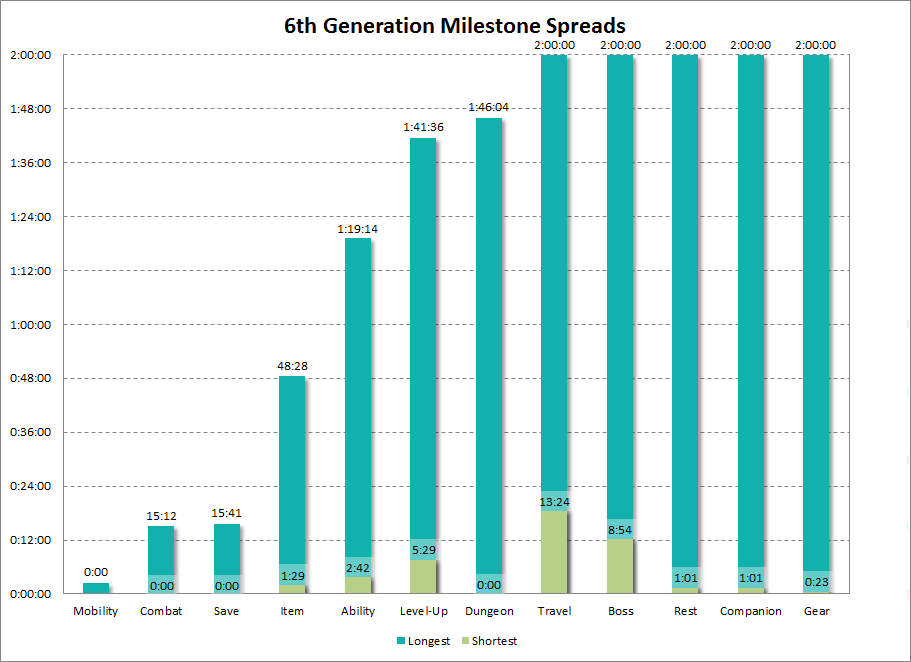
The milestone spreads generally increased as well, with five different ones falling outside the 2-hour limit (compared to just two in the 5th generation, and only one in the 4th). This indicated a larger divergence in JRPG pacing, although mobility, combat, and saving all shrunk down to become a universal core of the early-game.
Obtaining unique abilities also got slotted in earlier, which was indicative of more complex progression mechanisms. Leveling up actually leapfrogged the ability milestone, showing a clear desire to give the player something cool to play with early on in the experience.
I was actually surprised to see all milestones present in every game, although only four of them managed to hit FTC. Out of these, The Thousand-Year Door was the quickest to the mark, coming in at just under 1 hour despite its plentiful, hand-holding tutorials. However, the FTC metric became something of a misnomer as entirely new mechanics were being introduced 5-10 hours into various titles.
Combat typically stuck to the smaller cast of the previous generation -- three party members, and a similar amount of foes. Long attack animations got curtailed, but combat wasn't really faster due to additional meta mechanics. Keeping track of turns-lists, common resource pools, physical navigation of the battlefield, and completing input minigames all worked to extend the battles.
The combatants themselves also got more customizable and tended to stay in the party instead of departing for narrative reasons. This presented XP-distribution and character-progression issues, and the higher fidelity presentation made the "reserve squad" that much sillier to witness. Even when fighting in open fields, only the current party could attack the enemy forces. Other companions could tag-in, but if everyone on-screen died, the fight was over.
These types of suspension-of-disbelief problems became extremely common in the 6th generation. As JRPG visuals got less abstract, their mechanics became more so. This "systemization" became a big part of how the games were advertised, and convoluted gameplay ideas always seemed to trump narrative and worldbuilding concerns.
The upside of a willingness to experiment was that the games were more mechanically varied than I anticipated. There might not have been any titles quite as unique as Panzer Dragoon Saga, but Minstrel Song, Dragon Quarter, Mana Khemia, and various others prevented the genre from becoming trite.
What did leave a sour taste in my mouth were the character-driven stories.
Most narratives were incredibly juvenile and formulaic, endlessly regurgitating Shonen Jump tropes. There was rarely an attempt to appeal to a broader audience, or to even diversify within the existing one by taking cues from YA novels and other Western media. This rigidity left me feeling alienated and made me wonder -- could JRPG storytelling ever move in a different direction?
Read more about:
Featured BlogsYou May Also Like